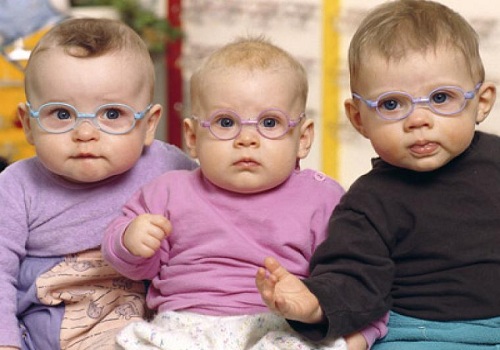How to identify the vision problems in babies?
The newborn has poorly developed vision, but he/she matures rapidly in his/her first months and is almost completed by three years. In fact, from the first month, babies begin to notice the lights, objects and gradually begin to follow them.
When the eye is not able to focus the image on the retina, refractive errors arise, so it is essential that from an early age children go to child health checks that allow them to detect a problem in vision and correct them as soon as possible.
However, when should parents start to worry? Is there any signal that helps them detect if there is a problem?
The first warning signal would be given by the parents, if they observe that the babies do not achieve this progress (look at lights and objects and follow them). In those situations they would have to suspect a possible visual disturbance in both eyes. «On the other hand, we will suspect a vision problem in one eye, if the baby refuses to have the opposite eye covered, if we see that he/she twists his/her bad eye or if the reflection of the light in his/her pupil is altered.
Among the eye problems that may appear more frequent in infants and children are refractive defects (the need for glasses), amblyopia or lazy eye and strabismus. Problems that, in most cases, can be prevented by performing periodic ophthalmologic check-ups in which experts will verify that the visual system is developing correctly and, if there is any alteration, will correct it before more problems are triggered.

What are the consequences if they are detected late?
“The child’s visual system is in continuous development and maturation. The sooner the visual problems are detected and treated, the better your visual system can develop, ”if these alterations are diagnosed late, the harder it will be to correct them and more aggressive treatments will have to be used for a longer period of time. In addition, in some cases some deficiencies will be linked with others.
“For example, if a child has a refractive defect, it can lead him to develop amblyopia or lazy eye and strabismus. If the glasses are put on them on time, it will not be necessary to treat the lazy eye with a patch and strabismus will be avoided. If these alterations are not detected and treated early, in many cases optimal results cannot be achieved, that is, a vision of one hundred percent with both eyes, with a correct alignment and a good three-dimensional vision or stereopsis ”
When the problem is detected by experts, they can apply several treatments:
• Refractive defects are treated with glasses, although when the child reaches pre-adolescence, the use of contact lenses can also be considered.
• In the case of amblyopia or lazy eye the treatment will vary depending on the causes. “The most common are the difference in graduation between the two eyes and strabismus. There are more serious and less frequent cases, such as having anatomical alterations in the eye that prevent normal visualization of the image: congenital cataracts, palpebral ptosis or droopy eyelid, retinal or optic nerve malformations, etc. ”, for the first case , the correction of the cause is possible and, in the second, the treatment is aimed at favoring the brain to perceive the image of the lazy eye by penalizing the image of the good eye, by patching, a few drops that dilate the pupil (atropine) or other methods.
• As for strabismus, some can be corrected with glasses. If these do not work, experts will resort more aggressive methods that act on extra ocular muscles, such as surgery or botulinum toxin injection.
“Although they do not observe any visual problems in their children, it is recommended that they accompany them to periodic reviews because many alterations are invaluable; the sooner they are diagnosed, the easier and more effective the treatment will be.
For more information, visit your doctor; not self-medicate; or write us.


